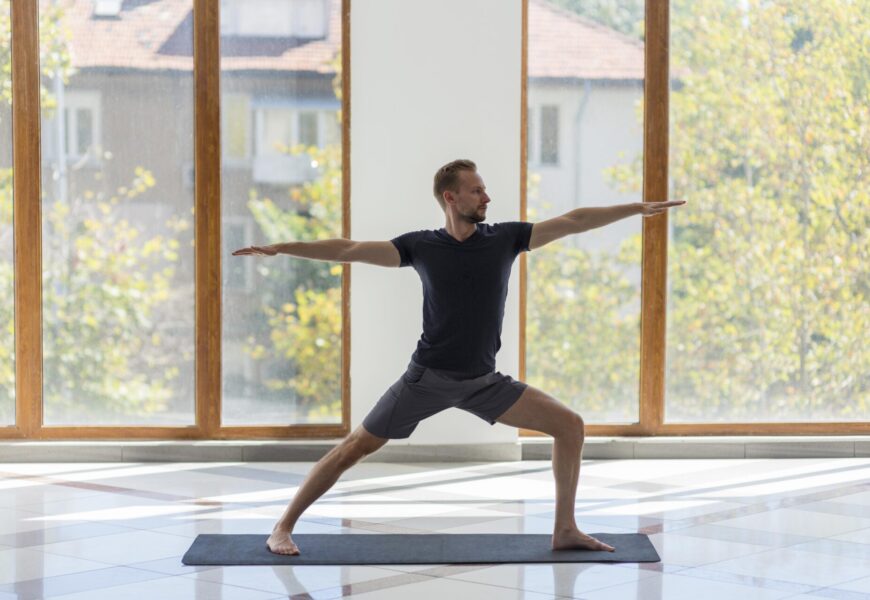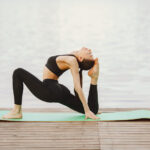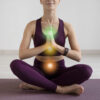Welcome to the world of Iyengar Yoga, a transformative practice that combines physical postures, breath control, and mindfulness to nurture your body and mind.
Named after its founder, B.K.S. Iyengar, this yoga style traces its roots to a humble beginning in India. B.K.S. Iyengar, who overcame health challenges through yoga, dedicated his life to perfecting this method, making it accessible to people of all ages and abilities.
Iyengar Yoga has evolved into a comprehensive system with a rich history, known for its precision and emphasis on proper alignment in each pose.
So, whether you’re a beginner or an experienced yogi, get ready to explore the world of Iyengar Yoga, where you’ll not only enhance your physical well-being but also embark on a journey of self-discovery and inner peace.
What Is Iyengar Yoga?
Iyengar Yoga is a unique style of yoga that places a strong emphasis on precision and alignment in yoga poses. Unlike some other types of yoga that may flow quickly from one pose to another, Iyengar Yoga takes its time.
It’s like the slow and steady tortoise in the yoga world. In Iyengar Yoga, you’ll often find yourself holding poses for longer periods, paying careful attention to the positioning of every body part, from your toes to your fingertips.
This style also loves to use props like yoga blocks, straps, and blankets, making it accessible for people of all levels, from absolute beginners to experienced yogis.
The props help you get into the poses with more comfort and correctness.
The ultimate goal of Iyengar Yoga is not just to stretch and strengthen your body but also to improve your mental focus and awareness.
It’s like a mindful workout for both your body and your mind.
The History Of Iyengar Yoga
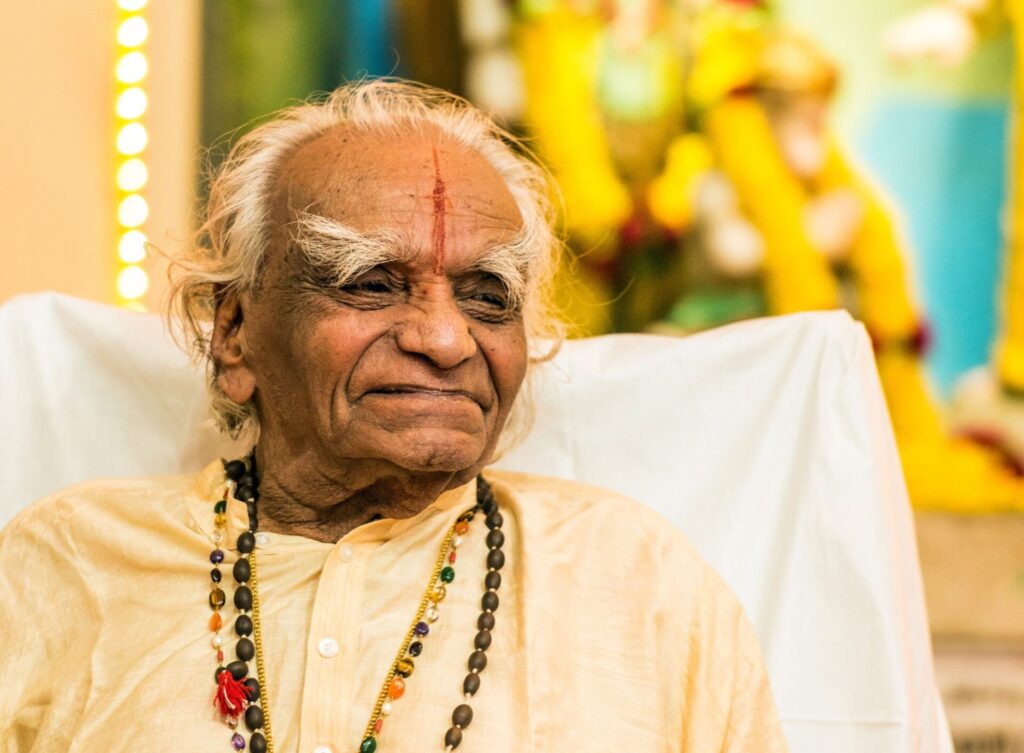
Iyengar Yoga has a fascinating history that traces its roots back to the pioneering efforts of B.K.S. Iyengar, an extraordinary yogi from India.
Born in 1918, Iyengar faced health challenges in his early life, which led him to seek the healing power of yoga.
His journey into yoga began under the guidance of his brother-in-law, the renowned yoga teacher Tirumalai Krishnamacharya.
With dedication and relentless practice, Iyengar not only overcame his health issues but also delved deep into the science of yoga.
What sets Iyengar Yoga apart is its meticulous focus on alignment and precision in postures (asanas) and the innovative use of props like belts, blocks, and ropes to help practitioners achieve proper alignment.
B.K.S. Iyengar’s teachings gained recognition in the mid-20th century when he published his seminal work “Light on Yoga,” which became a global bestseller and introduced the world to the transformative potential of yoga.
Iyengar Yoga’s journey continued to evolve, with B.K.S. Iyengar spreading his teachings worldwide, including establishing yoga institutes and centers across the globe.
His dedication to the art of yoga and his tireless efforts to make it accessible to people of all backgrounds have left an indelible mark on the modern yoga landscape.
Today, Iyengar Yoga remains a respected and influential tradition known for its precision, therapeutic approach, and the profound impact it has on the physical, mental, and spiritual well-being of its practitioners.
Iyengar Yoga Benefits
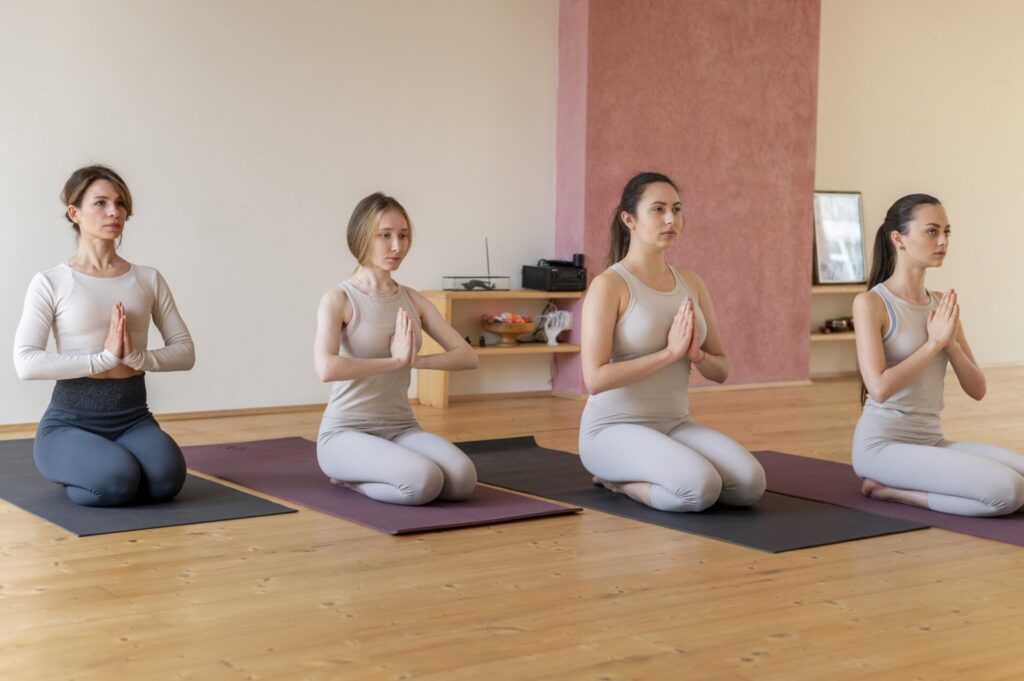
Physical Benefits
Improved Flexibility:
Iyengar Yoga’s profound impact on flexibility is an extraordinary journey of transformation. Through the systematic practice of asanas, you will witness your body gradually becoming more pliant and supple.
Each pose, supported by props and guided by precise alignment, encourages the gentle release of tension in your muscles and the lengthening of connective tissues.
This newfound flexibility means that you can reach, bend, and twist more effortlessly, not only on the yoga mat but in your daily life as well.
As the weeks and months pass, you may find that tasks that once felt rigid or uncomfortable now come with an increased range of motion, making physical activities less challenging and more enjoyable.
Enhanced Strength:
Surprisingly, Iyengar Yoga is not solely about flexibility; it is also a potent tool for building strength. By holding poses and maintaining correct alignment, you engage and challenge various muscle groups.
This deliberate muscular engagement not only helps you stay steady within the poses but also develops muscular endurance.
Your enhanced strength doesn’t just benefit your yoga practice; it also carries over into everyday life.
You’ll discover an increased capacity for activities that require physical strength, from carrying groceries to performing household tasks with greater ease.
Better Posture:
Iyengar Yoga is a remarkable facilitator of improved posture. The emphasis on proper alignment and body awareness during practice results in a profound impact on your everyday stance.
Over time, you’ll notice that you naturally adopt a more upright and balanced posture, minimizing the strain on your neck, shoulders, and back.
This leads to less discomfort and fatigue during prolonged periods of sitting or standing.
Enhanced posture not only benefits your physical well-being but also projects a sense of confidence and grace in your daily interactions, positively affecting how you present yourself to the world.
Mental Benefits
Stress Reduction:
Iyengar Yoga provides a sanctuary of serenity in the midst of life’s relentless demands. By focusing on the union of body and mind through mindful breathing and precise poses, this practice is a powerful stress-reduction tool. It encourages you to leave your worries behind and be fully present in the moment.
This mindfully structured escape from the daily hustle and bustle allows your nervous system to unwind, calming the mind, lowering stress hormones, and eliciting a deep sense of relaxation.
The breath is your anchor, and each pose becomes an opportunity to release tension, ultimately leading to a profound sense of inner peace and tranquility.
Mental Clarity And Focus:
Beyond the physical aspects, Iyengar Yoga delves into the realm of mental clarity and concentration.
The practice cultivates a heightened awareness of your breath and body, helping you disconnect from the ceaseless mental chatter.
As you enter a state of mindful presence, your ability to focus sharpens. This newfound mental clarity enables you to concentrate on tasks with a clear, undistracted mind.
Whether you’re tackling a complex work project or simply seeking a deeper understanding of your inner self, Iyengar Yoga empowers you to navigate life’s challenges with a greater sense of purpose and direction.
Emotional Balance:
Iyengar Yoga offers a unique avenue for exploring and managing your emotions. By encouraging self-reflection and self-awareness during your practice, you develop a profound understanding of your emotional landscape. This understanding equips you with the tools to navigate your emotions skillfully.
Over time, you’ll find yourself better equipped to manage stress, anxiety, and the ups and downs of life.
The practice fosters emotional resilience and balance, promoting a harmonious relationship with your inner world and a greater capacity to respond to life’s challenges with grace and equanimity.
Therapeutic Benefits
Pain Relief And Management:
Iyengar Yoga offers a gentle yet powerful approach to pain relief and management. Through carefully designed poses and the use of props, it provides a structured method for addressing chronic pain.
Whether it’s lower back discomfort, arthritis, or muscle tension, the practice aims to release tension and promote healing.
The precise alignment and sequencing of poses facilitate the body’s ability to relax and reduce pain.
By gradually easing muscular tension, Iyengar Yoga leads to improved comfort and enhances the quality of life for those dealing with persistent pain.
Rehabilitation After Injuries:
Iyengar Yoga’s adaptability and focus on alignment make it invaluable for post-injury recovery.
It offers a safe and controlled environment to rebuild strength, flexibility, and confidence after injuries like sports-related mishaps or surgeries.
With the guidance of experienced instructors, individuals can customize their practice to suit their unique needs and limitations.
Systematically practicing modified poses, fosters empowerment, patience, and self-compassion during the healing process. This approach encourages a gradual return to daily activities, improving one’s overall quality of life.
Benefits For Specific Health Conditions:
Iyengar Yoga’s adaptability extends to tailored practices for individuals managing specific health conditions.
Whether it’s hypertension, asthma, or insomnia, Iyengar Yoga provides a supportive and complementary approach to overall well-being.
It promotes relaxation and mindful breathing, helping reduce blood pressure for those with hypertension.
Specific breathing techniques enhance lung function and respiratory resilience in individuals with asthma.
Those battling insomnia benefit from the practice’s stress-reducing elements, leading to improved sleep quality.
By working closely with healthcare professionals, Iyengar Yoga instructors create personalized routines to address specific health concerns, emphasizing the mind-body connection and promoting physical and emotional well-being.
Holistic Well-Being
Mind-Body Connection:
Iyengar Yoga goes beyond physical poses; it encourages a profound connection between the mind and body.
By paying attention to breath, sensations, and alignment during practice, practitioners develop a heightened awareness of how their bodies function.
This increased awareness extends to daily life, enabling conscious choices that support physical and mental well-being.
The mind-body connection is at the core of Iyengar Yoga, guiding individuals toward unity, balance, and greater overall well-being.
It offers a path to self-discovery and inner harmony, allowing individuals to navigate life with increased mindfulness.
Improved Quality Of Life:
Iyengar Yoga is not solely about physical exercise; it’s a comprehensive approach to enhancing the quality of life.
It empowers individuals to lead more fulfilling and healthier lives by providing practical tools for self-improvement and self-care.
The practice influences daily choices, reducing stress, promoting emotional resilience, and encouraging self-awareness. Iyengar Yoga fosters self-compassion and mindfulness, enriching one’s quality of life.
It’s a holistic practice that extends beyond the yoga mat, offering a balanced and meaningful way of living.
Through mindfulness and self-discovery, it guides individuals toward an improved quality of life.
How To Get Started With Iyengar Yoga
Finding A Qualified Instructor
To embark on your Iyengar Yoga journey, it’s crucial to find a skilled and certified instructor.
Look for someone who has undergone rigorous training in this specific yoga style. They’ll guide you through proper alignment, provide personalized feedback, and ensure your safety during practice.
You can check online directories, ask for recommendations from friends, or visit local yoga studios to find a qualified Iyengar Yoga instructor.
Necessary Equipment And Props
Iyengar Yoga relies on various props like yoga blocks, belts, bolsters, and wall ropes to assist in achieving correct alignment and making poses accessible.
When starting out, you won’t need to buy all these props immediately. Most yoga studios provide them for class use.
However, having a good quality yoga mat is essential. As you progress, you can gradually invest in additional props based on your needs and preferences.
Preparing Your Practice Space
Creating a conducive environment for your Iyengar Yoga practice is vital. Choose a quiet, clean, and clutter-free area where you won’t be disturbed.
Ensure proper ventilation and lighting. Set up your yoga mat and props neatly so that they’re easily accessible during your practice.
This dedicated space will help you stay focused and committed to your practice.
Understanding Your Body And Limitations
Before diving into complex poses, take time to understand your body and its limitations. Iyengar Yoga encourages self-awareness and self-acceptance. Listen to your body, respect its boundaries, and avoid pushing yourself too hard.
Communicate openly with your instructor about any injuries or health concerns, so they can modify poses or suggest alternatives to suit your needs.
Remember, progress in yoga is a personal journey, and patience is key.
Iyengar Yoga Sequences And Pranayama
Asanas (Yoga Poses)
In Iyengar Yoga, a key focus is on doing yoga poses, which we call “asanas,” with careful attention to how your body is aligned and positioned. Precision is crucial here – it’s like a game of lining up all the parts of your body just right.
Imagine trying to build a tall and stable tower using blocks. Each block (your body part) needs to be perfectly stacked to create a strong structure.
Here are some key Iyengar yoga poses:
Tadasana (Mountain Pose)

Tadasana, or Mountain Pose, serves as the foundational pose for many standing asanas in Iyengar Yoga.
To perform this pose, stand with your feet hip-width apart, grounding your weight evenly across both feet.
The key focus is on aligning the body, from the feet to the head, in a way that encourages stability and balance.
The arms rest by your sides, palms facing forward. Tadasana is an excellent pose for improving posture, strengthening the legs, and increasing body awareness.
By practicing Tadasana regularly, you can develop a strong foundation for other standing poses, as it teaches you to engage the muscles, lengthen the spine, and find balance within your body.
Utthita Trikonasana (Extended Triangle Pose)
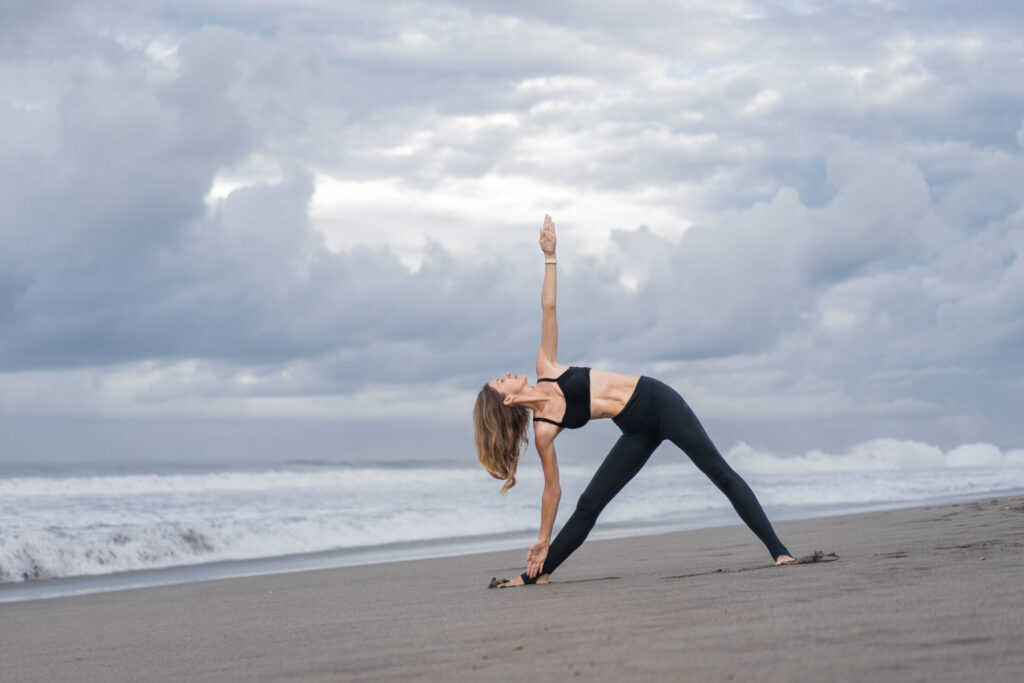
Utthita Trikonasana, or Extended Triangle Pose, is a fundamental standing pose that helps to improve flexibility and strength in the legs and spine.
To perform this pose, start in a wide-legged stance, extending one leg out to the side and reaching down to touch the ankle or the floor with one hand, while the other arm stretches upward.
This asana engages the entire body, especially the legs, hips, and core muscles. It’s beneficial for increasing spinal flexibility and relieving lower back pain. Additionally, it helps improve balance and coordination.
Utthita Trikonasana is often used as a building block for more advanced standing poses.
Virabhadrasana II (Warrior II Pose)
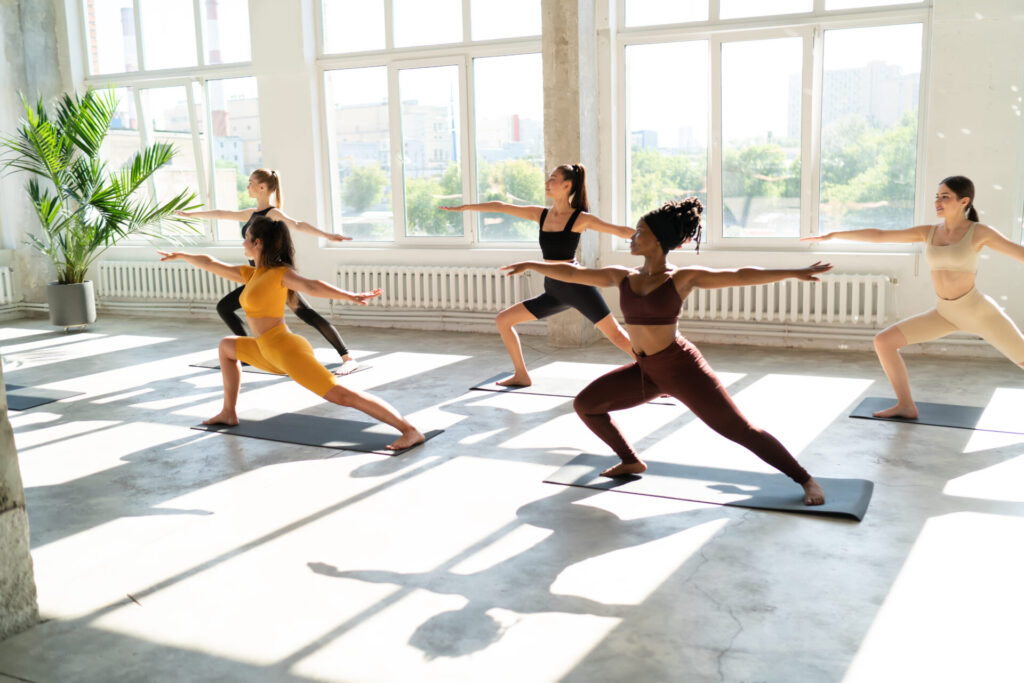
Virabhadrasana II, or Warrior II Pose, is a powerful standing pose that develops strength and stability in the legs, hips, and core.
To perform this pose, stand with your feet wide apart, extend your arms out to the sides, and bend one knee to a 90-degree angle while keeping the other leg straight.
Warrior II builds strength and endurance in the legs, enhancing overall lower-body fitness. It also encourages a sense of inner strength and focus.
The pose symbolizes a warrior’s readiness and determination, both of which are qualities that can be cultivated through consistent practice.
Sukhasana (Easy Pose)
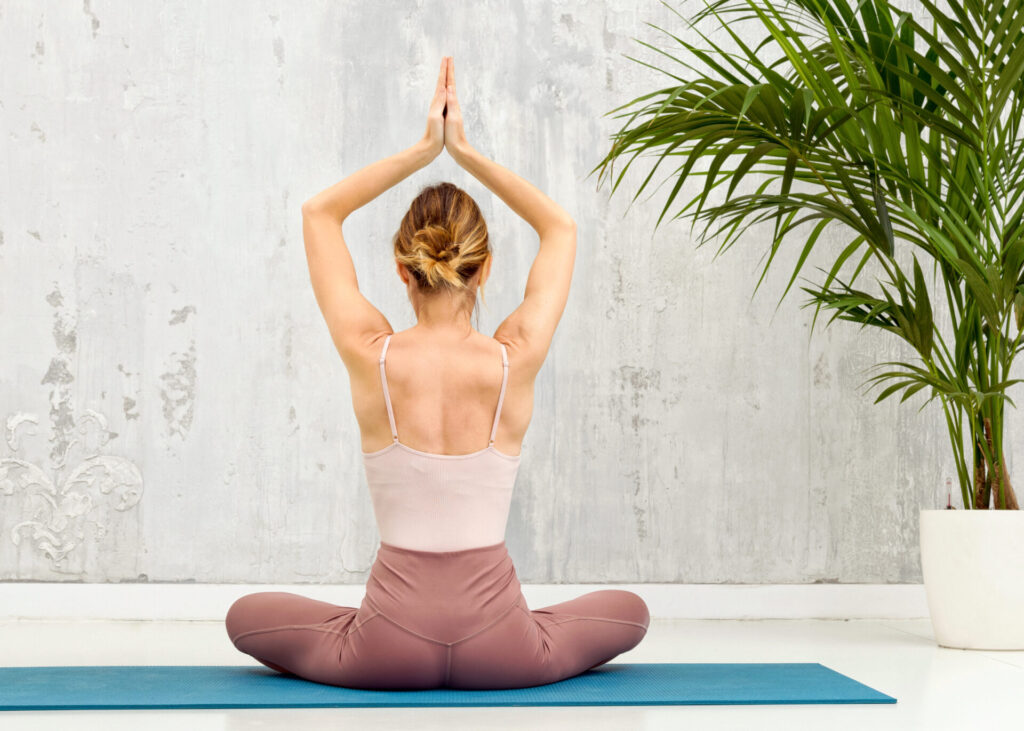
Sukhasana, or Easy Pose, is a comfortable seated position often used for meditation and pranayama (breath control) in Iyengar Yoga.
To perform this pose, sit with your legs crossed and your hands resting on your knees or in your lap. Sukhasana encourages an upright posture, which is essential for effective meditation and breathing exercises.
It is a pose that promotes relaxation and inner calm. By sitting in Sukhasana, you can enhance your ability to focus, release tension, and create a stable foundation for more advanced seated postures.
Baddha Konasana (Bound Angle Pose)
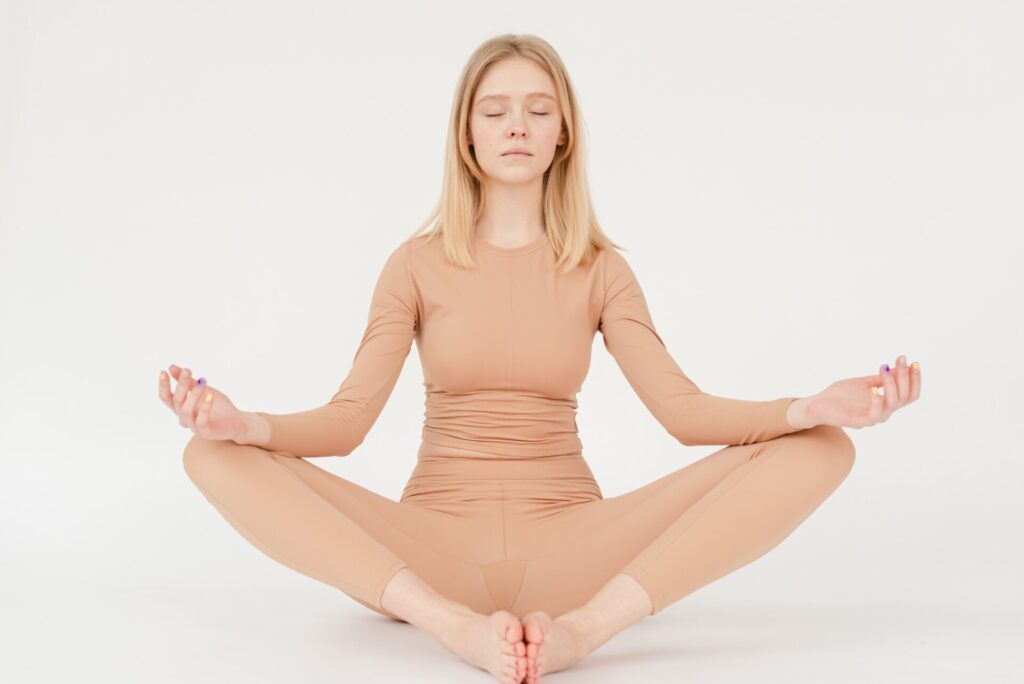
Baddha Konasana, or Bound Angle Pose, is a seated pose that targets the groin, hips, and inner thighs.
To perform this pose, sit with your legs bent and the soles of your feet together, allowing your knees to fall outward.
This asana encourages a deep stretch in the hips and can be useful for improving flexibility in the hip region.
Baddha Konasana is often included in Iyengar Yoga sequences to prepare the body for more advanced seated postures or forward bends.
Paschimottanasana (Seated Forward Bend)

Paschimottanasana, or Seated Forward Bend, is a seated pose that involves folding the upper body forward to reach for the toes.
To perform this pose, sit with your legs extended in front of you and hinge at the hips to bring your torso forward, reaching for your feet.
Paschimottanasana stretches the entire back of the body, including the spine, hamstrings, and calves.
It is a calming pose that encourages introspection and relaxation. In Iyengar Yoga, it is often used to improve flexibility and lengthen the spine.
Bhujangasana (Cobra Pose)
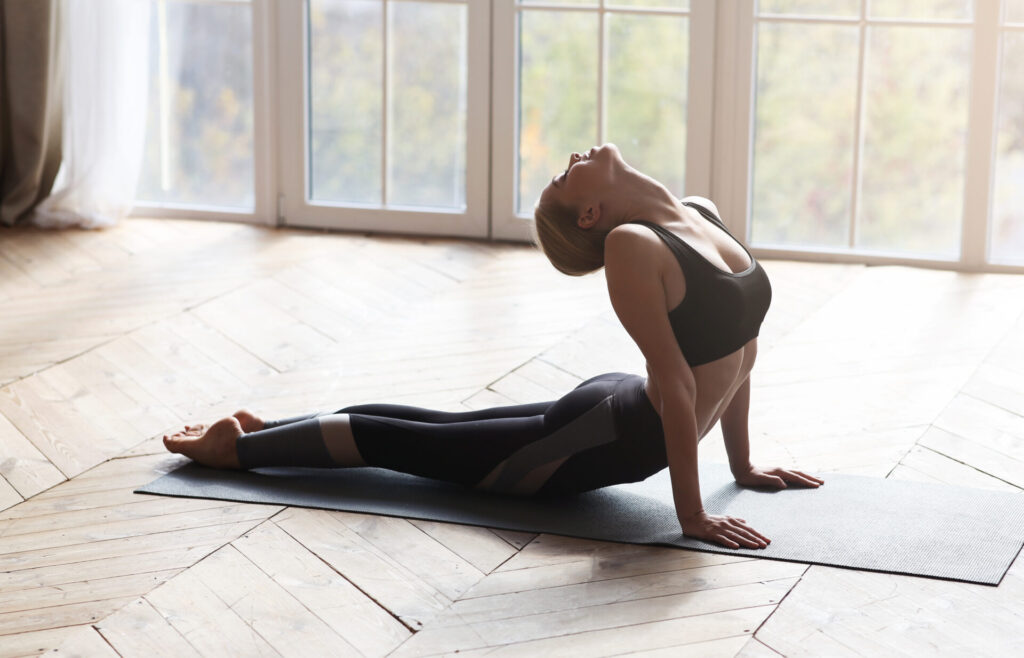
Bhujangasana, or Cobra Pose, is a prone pose that involves lifting the upper body while keeping the legs and pelvis on the floor.
To perform this pose, lie face down with your palms under your shoulders, and then lift your chest and head off the ground.
Cobra Pose is a gentle backbend that helps strengthen the spine and relieve tension in the lower back.
It also opens the chest, stretches the abdominal muscles, and promotes flexibility in the spine.
Salabhasana (Locust Pose)
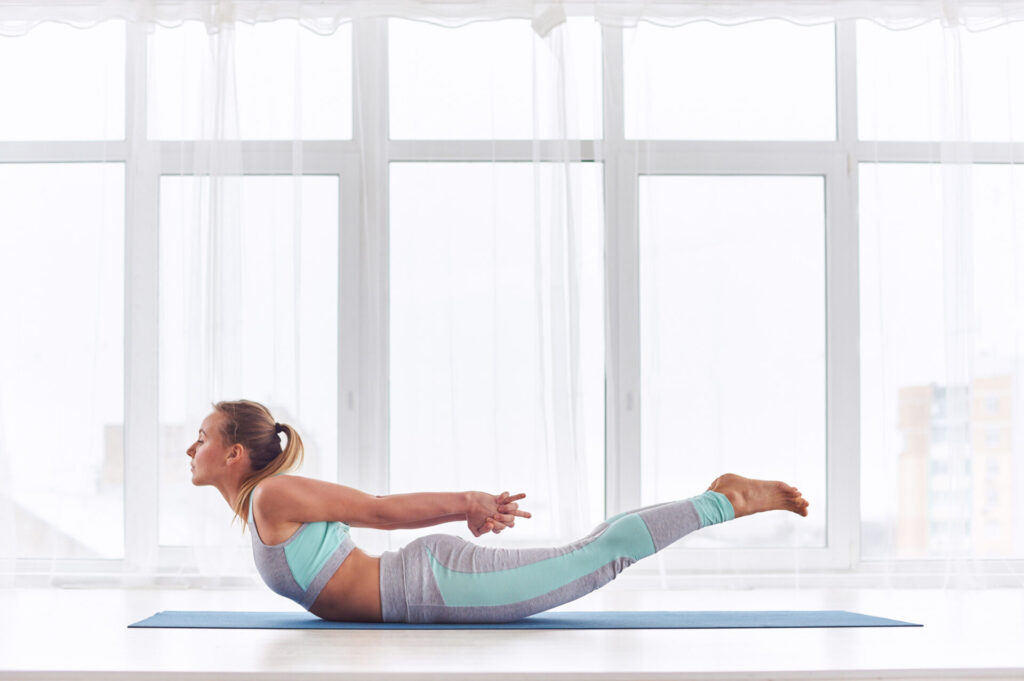
Salabhasana, or Locust Pose, is another prone pose that strengthens the back, buttocks, and legs.
To perform this pose, lie face down with your arms at your sides and then lift your chest, arms, and legs off the ground.
Salabhasana helps improve posture and alleviate lower back pain. It also enhances the strength of the muscles along the spine, making it an excellent preparatory pose for more advanced backbends and inversions.
Pranayama (Breath Control)
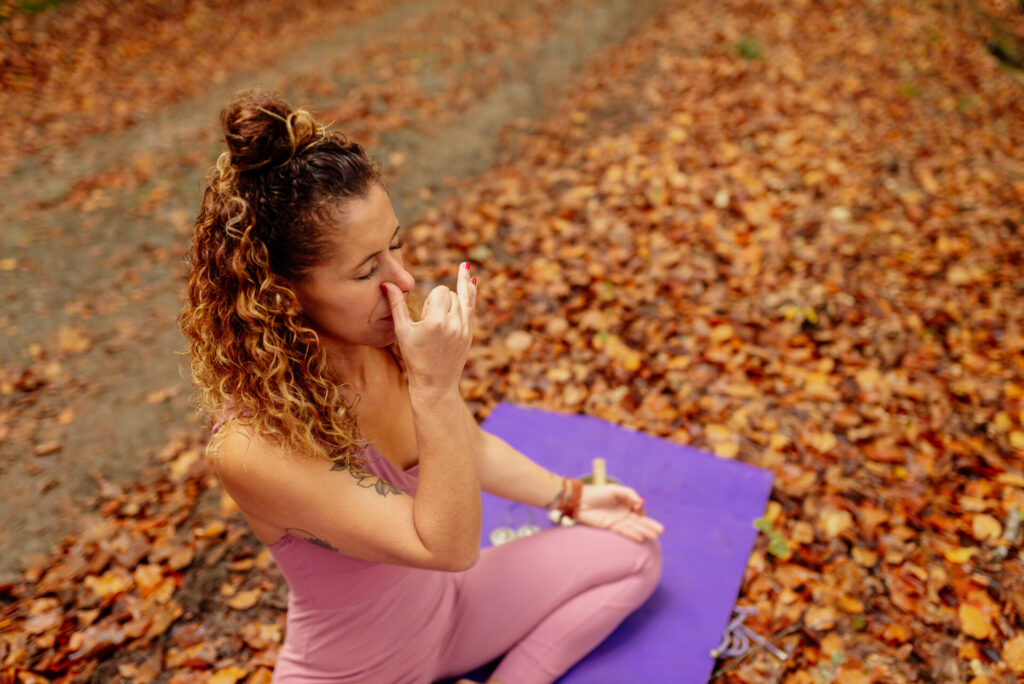
In Iyengar Yoga, we don’t just focus on physical poses; we also pay close attention to our breath. Think of it as the wind that fills the sails of a boat.
Without the wind (your breath), the boat (your practice) won’t move. The importance of breath in Iyengar Yoga cannot be overstated. It’s like the thread that weaves through the fabric of your practice, connecting every part.
Pranayama techniques are like tools that help you control and deepen your breath. It’s not just about inhaling and exhaling; it’s about doing it with purpose and awareness.
For example, “Ujjayi Pranayama” involves breathing in a way that creates a gentle sound like ocean waves, helping you stay focused and calm during your practice.
These breathing exercises help you harness the power of your breath, promoting better oxygenation, relaxation, and concentration.
Meditation And Relaxation
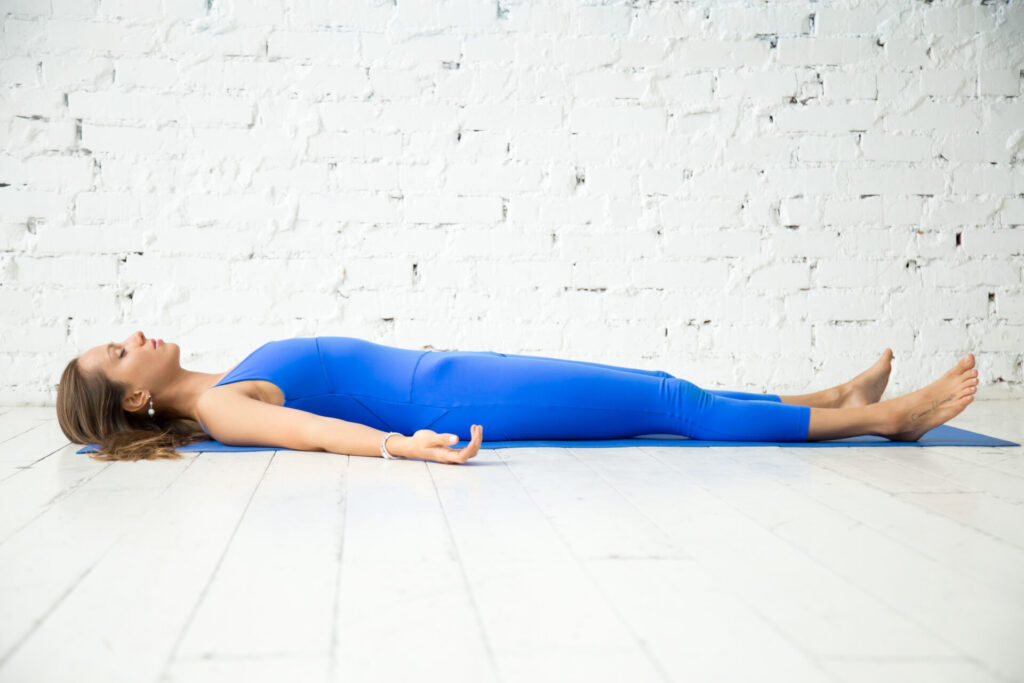
Yoga is not just about physical exercise; it’s also about finding peace and calm within. In Iyengar Yoga, we incorporate mindfulness into our practice. It’s like taking a mental vacation, allowing you to unwind and recharge.
During your practice, you’ll learn to be fully present, just like when you’re savoring a delicious meal or enjoying a beautiful sunset.
It’s about being here, in this moment, and letting go of worries about the past or the future.
Another wonderful practice in Iyengar Yoga is “Yoga Nidra.” It’s a bit like a power nap for your mind and body.
You lie down comfortably, and while you rest, you’re guided through a relaxation journey.
It’s incredibly soothing and rejuvenating, like a reset button for your whole being. Yoga Nidra can help reduce stress, improve sleep, and leave you feeling refreshed as if you’ve just had a long, peaceful sleep.
Iyengar Yoga Institute: Where Can You Find It?
The Iyengar Yoga Institute is like a hub where people gather to learn and practice Iyengar Yoga. These institutes are located in different parts of the world, so there’s a good chance you’ll find one near you.
Some of the most well-known ones are in places like Pune, India, which is where B.K.S. Iyengar, the founder of this style, lived and taught.
There are also institutes in places like the United States, the United Kingdom, and many other countries.
Each institute is like a community center for yoga enthusiasts, offering classes, workshops, and Iyengar teacher training programs.
So, if you’re keen to explore Iyengar Yoga more deeply, you can check for the nearest Iyengar Yoga Institute in your area and start your yoga journey there.
Final Thoughts
Iyengar Yoga is like a wellspring of goodness for your body and mind. As you’ve journeyed through this guide, you’ve discovered that it’s not just about bending into fancy poses; it’s a path to improving your life.
The physical benefits, like becoming more flexible and strong, are only the beginning. This yoga also helps you manage stress, find focus, and bring harmony to your emotions.
So, don’t just let this knowledge gather dust—take it with you. Whether you’re a seasoned yogi or a newbie, let Iyengar Yoga be your companion on your road to a healthier, happier you.
With practice, you can make it a part of your daily life and reap the countless rewards it has to offer.

